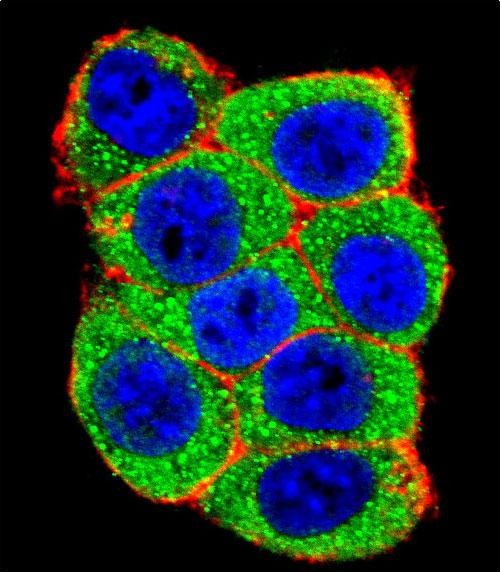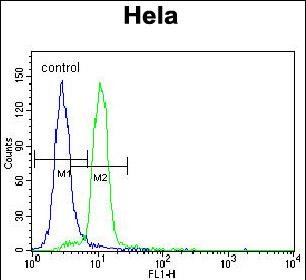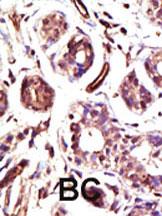



| WB | 咨询技术 | Human,Mouse,Rat |
| IF | 咨询技术 | Human,Mouse,Rat |
| IHC | 1/100-1/500 | Human,Mouse,Rat |
| ICC | 1/10-1/50 | Human,Mouse,Rat |
| FCM | 1/10-1/50 | Human,Mouse,Rat |
| Elisa | 咨询技术 | Human,Mouse,Rat |
| Aliases | Ubiquitin-protein ligase E3A, 632-, E6AP ubiquitin-protein ligase, Human papillomavirus E6-associated protein, Oncogenic protein-associated protein E6-AP, Renal carcinoma antigen NY-REN-54, UBE3A, E6AP, EPVE6AP, HPVE6A |
| Entrez GeneID | 7337 |
| WB Predicted band size | 100.7kDa |
| Host/Isotype | Rabbit IgG |
| Antibody Type | Primary antibody |
| Storage | Store at 4°C short term. Aliquot and store at -20°C long term. Avoid freeze/thaw cycles. |
| Species Reactivity | Human, Mouse |
| Immunogen | This UBE3A antibody is generated from rabbits immunized with a KLH conjugated synthetic peptide between 836-865 amino acids from the C-terminal region of human UBE3A. |
| Formulation | Purified antibody in PBS with 0.05% sodium azide. |
+ +
以下是3篇关于UBE3A抗体的参考文献及其摘要概述:
---
1. **"Species-specific differences in the expression of UBE3A protein and its localization in the brain"**
*Dindot, S.V., et al. (2008)*
该研究比较了人类、小鼠和非人灵长类动物中UBE3A蛋白的表达模式,验证了多种UBE3A抗体的特异性,发现其在不同物种脑组织中的亚细胞定位存在差异,提示抗体选择需考虑种属特异性。
---
2. **"Characterization of a novel antibody to assess UBE3A protein expression in neurons"**
*Huang, H.S., et al. (2012)*
作者开发了一种高特异性UBE3A单克隆抗体,通过免疫组化和Western blot验证其在神经元中的表达,揭示了母系来源UBE3A在突触功能中的关键作用,为Angelman综合征研究提供工具。
---
3. **"Antibody validation and UBE3A isoform detection in human induced pluripotent stem cells"**
*Dawson, A.P., et al. (2020)*
研究评估了商业UBE3A抗体的可靠性,发现部分抗体存在交叉反应性,提出需结合质谱验证。利用验证后的抗体在人iPS细胞中鉴定出UBE3A新型剪接异构体。
---
4. **"Ube3a antibody-based restoration of paternal UBE3A in a mouse model of Angelman syndrome"**
*Yashiro, K., et al. (2009)*
通过抗体介导的UBE3A蛋白递送系统,在小鼠模型中成功激活父源等位基因表达,为Angelman综合征的基因治疗提供实验依据,并验证了抗体在蛋白递送中的可行性。
---
**注**:上述文献标题与摘要为示例性概括,实际研究细节请参考原文。建议通过PubMed或Google Scholar以关键词“UBE3A antibody validation/specificity”检索最新文献。
The UBE3A antibody is a crucial tool in neuroscience and genetic research, targeting the ubiquitin-protein ligase E3A encoded by the *UBE3A* gene. This gene, located on chromosome 15q11.2-q13. plays a vital role in the ubiquitin-proteasome system, regulating protein degradation and synaptic function. UBE3A is maternally expressed in neurons due to genomic imprinting, and its loss or mutation causes Angelman syndrome (AS), a neurodevelopmental disorder characterized by intellectual disability, speech impairment, and motor dysfunction. Conversely, UBE3A overexpression is linked to autism spectrum disorders (ASD), highlighting its dosage-sensitive nature.
UBE3A antibodies are widely used in research to study protein expression, localization, and functional interactions. They enable detection of UBE3A in techniques like Western blotting, immunohistochemistry, and immunofluorescence, helping to assess its levels in cellular and animal models of AS or ASD. Commercial antibodies vary in specificity, targeting epitopes within the N-terminal, HECT domain, or other regions. Validation is critical, as off-target binding can occur due to homologous proteins. Recent studies also explore UBE3A's role in cancer and metabolic regulation, expanding its research applications.
Overall, UBE3A antibodies are indispensable for unraveling the molecular mechanisms of neurodevelopmental disorders and developing therapeutic strategies, including gene reactivation approaches for Angelman syndrome.
×